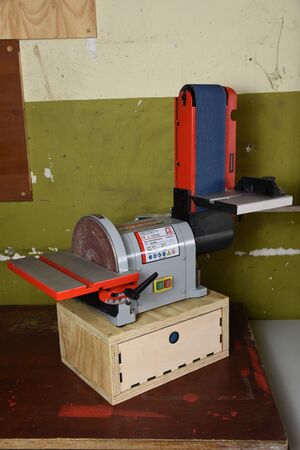Belt and Disc Sander: Difference between revisions
mNo edit summary |
m (→Sandpaper Cleaning: removed expired hyperlink) |
||
| (30 intermediate revisions by 5 users not shown) | |||
| Line 1: | Line 1: | ||
{{MachineInfoBox | {{MachineInfoBox | ||
|machine name= | |machine name=Belt and Disc Sander | ||
|german=Band- und Tellerschleifer|image=beltdiscsander.jpg | |german=Band- und Tellerschleifer | ||
|synonyms=| | |image=beltdiscsander.jpg | ||
| | |synonyms=belt and disk sander,<br>belt and disc sanding machine (BDSM);<br>DE: Band- und Tellerschleifer (oder Schleifteller) | ||
| | |manual=in wooden box below the machine /<br>[https://www.manualslib.de/manual/513926/Holzmann-Bt-75.html similar machine on manualslib] | ||
| | |material=[[wood]], [[metal]] | ||
| | |used with=[[Sanding Belts|sanding belts]],<br>[[Sanding Discs|sanding discs]] | ||
| | |similar=[[Belt Sander|belt sander]], [[Disc Sander|disc sander]] | ||
|type=Sanders | |||
|extrabox=yes | |||
}} | }} | ||
This type of machine is helpful for all sanding tasks that require a fixed angle. Both sander sides often have adjustable sanding tables and a slot for a miter gauge to guide your workpiece in a defined agle against the sanding disc or belt. | |||
== | == Safety == | ||
Always make sure to adhere to all precautions trained during the [[Stationary Sander Introduction|stationary sander introduction]]. | |||
== Maintenance == | |||
The machine does not require extensive maintenance. Service malfunctions and defects by trained persons only. Regular maintenance: | |||
* After each workshift: Remove chips and sanding dust from the device | |||
* After 10 hours of operation: Check all screw connections and tighten if necessary | |||
Refer to the manual in order learn more about the process to change the grinding belt and the disc. | |||
=== Sandpaper Cleaning === | |||
Sandpaper can be restored a few times before it is used up by briefly sanding a piece of rubber! Instead of proper [https://www.holz-metall.info/shop1/artikel8086.htm cleaning sticks] you can apparently get great results with the sole of an old shoe - any donors? ;-) | |||
<br clear=all> | |||
<!-- NOTE: The following block "imports" content from separate pages - please don't change the code! To edit the actual information, please go back and click "edit" next to the section headline you are interested in :-) --> | |||
{{#ask: | |||
[[MachineType::Belt and Disc Sander]] OR [[MachineType::Stationary Sander]] | |||
|order=descending | |||
|format=embedded | |||
|embedonly=yes | |||
| | |||
| | |||
| | |||
}} | }} | ||
[[Category:Sanders]] | |||
[[Category:Sanding]] | |||
[[Category:Woodworking]] | |||
Latest revision as of 15:07, 26 September 2024
| MachineInfoBox Belt and Disc Sander | |
|---|---|

| |
| Synonyms: | belt and disk sander, belt and disc sanding machine (BDSM); DE: Band- und Tellerschleifer (oder Schleifteller) |
| Material: | wood, metal |
| Used with: | sanding belts, sanding discs |
| Access Requirements: | Stationary Sander Introduction |
| Manual: | in wooden box below the machine / similar machine on manualslib |
| Tutors: | Lukas Pakue Johannes Luzian Utis Sebastian Jakob |
| Similar (More or Less): | belt sander, disc sander |
This type of machine is helpful for all sanding tasks that require a fixed angle. Both sander sides often have adjustable sanding tables and a slot for a miter gauge to guide your workpiece in a defined agle against the sanding disc or belt.
Safety
Always make sure to adhere to all precautions trained during the stationary sander introduction.
Maintenance
The machine does not require extensive maintenance. Service malfunctions and defects by trained persons only. Regular maintenance:
- After each workshift: Remove chips and sanding dust from the device
- After 10 hours of operation: Check all screw connections and tighten if necessary
Refer to the manual in order learn more about the process to change the grinding belt and the disc.
Sandpaper Cleaning
Sandpaper can be restored a few times before it is used up by briefly sanding a piece of rubber! Instead of proper cleaning sticks you can apparently get great results with the sole of an old shoe - any donors? ;-)